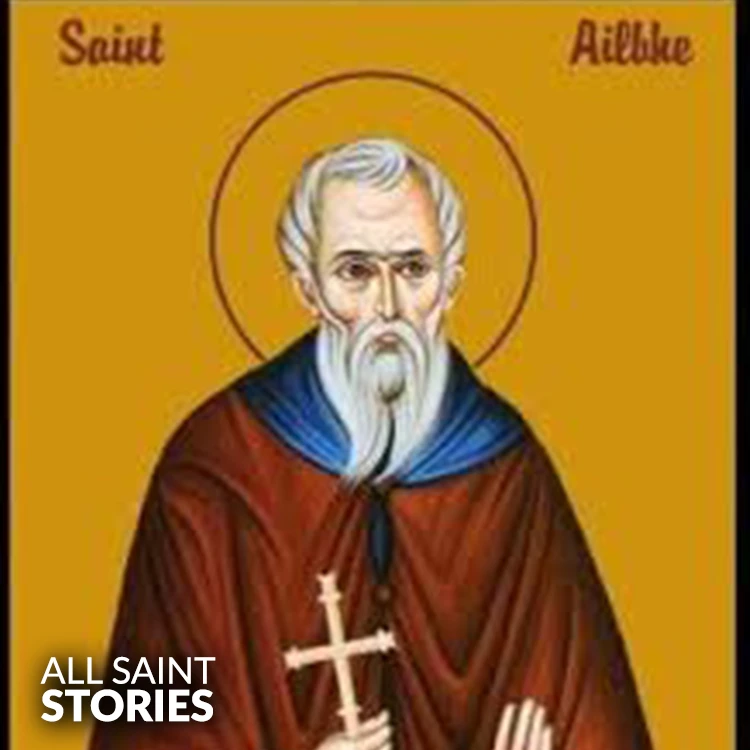St. Ailbe, pray for us to live with faith, compassion, and dedication to God. Guide us in our journey of holiness. Amen
ST. AILBE OF EMLY
ST. AILBE OF EMLY

St. Ailbe of Emly was an early Irish bishop and missionary credited with spreading Christianity in Munster before the arrival of St. Patrick. He founded a monastery at Emly, which became a major religious center. Known for miracles and his legendary upbringing by a wolf, he remains a revered figure in Irish Christian tradition.
St. Ailbe of Emly is one of the most venerated figures among Ireland’s early Christian missionaries, recognized for his deep impact in the region of Munster during the 5th or early 6th century. Unlike St. Patrick, who is widely celebrated as the primary figure in Ireland’s Christianization, Ailbe is often considered one of the "Four Pre-Patrician Saints"—alongside St. Declan, St. Ciarán of Saigir, and St. Ibar—who are believed to have evangelized parts of Ireland even before Patrick's mission began. These saints laid the groundwork for Christian faith in the country, and Ailbe was especially influential in the south.
The life of Ailbe, like many early saints, is interwoven with legend. According to tradition, he was born of noble lineage but was abandoned as an infant—an act known as exposure, common in some ancient societies. Ailbe was miraculously nurtured and raised by a she-wolf, an origin story that lent him a lasting spiritual connection to nature and animals. This relationship is so strong in folklore that he is sometimes referred to as the "Irish St. Francis." His image is often depicted with a wolf by his side, a reminder of this unique story.
Ailbe eventually came under Christian influence and received religious instruction, possibly abroad. Some traditions say he was ordained by a bishop on the continent, possibly in Gaul (modern-day France). Returning to Ireland, he began his missionary work in earnest, focusing on the region of Munster. His efforts led to the establishment of a Christian community in Emly, where he founded a monastery that would grow into one of the most important religious and cultural centers of early medieval Ireland.
As bishop of Emly, Ailbe became a spiritual leader not only in faith but also in learning. His monastery attracted followers and students, helping to spread Christian teachings throughout southern Ireland. Emly remained a major religious site for centuries, eventually becoming the seat of the Diocese of Emly and later being merged with the Archdiocese of Cashel.
Miracles are frequently attributed to Ailbe. These include healings and even the raising of the dead, common elements in hagiographies that reflect his spiritual authority. His compassion, strength, and missionary zeal are celebrated in Irish liturgical texts and annals. The "Martyrology of Tallaght" and the "Martyrology of Donegal" both list his feast on September 12, indicating widespread devotion.
Although exact dates of his life are uncertain, his death is commonly placed around 528. He was buried at Emly, which continued to honor him for generations. His canonization predates the formal canonization process developed by the Roman Catholic Church, so he is considered a pre-congregation saint, meaning his sainthood was recognized by popular acclaim and early Church tradition.
Today, while less globally known than St. Patrick, St. Ailbe holds a special place in the heart of Irish spirituality, particularly in Tipperary and Munster. Churches and schools across Ireland bear his name, and his story is still remembered in local tradition. His feast day on September 12 is a moment of celebration, especially in the Diocese of Cashel and Emly, where his influence continues to be felt.
Video Not Found
No images uploaded for this saint yet.
The information on this website is compiled from various trusted sources. While we aim for accuracy, some details may be incomplete or contain discrepancies.
If you notice any errors or have additional information about this saint, please use the form on the left to share your suggestions. Your input helps us improve and maintain reliable content for everyone.
All submissions are reviewed carefully, and your personal details will remain confidential. Thank you for contributing to the accuracy and value of this resource.
Credits & Acknowledgments
- Anudina Visudhar (Malayalam) – Life of Saints for Everyday
by Msgr. Thomas Moothedan, M.A., D.D. - Saint Companions for Each Day
by A. J. M. Mausolfe & J. K. Mausolfe - US Catholic (Faith in Real Life) – Informational articles
- Wikipedia – General reference content and images
- Anastpaul.com – Saint images and reflections
- Pravachaka Sabdam (Malayalam) – Saint-related content and insights
We sincerely thank these authors and platforms for their valuable contributions. If we have unintentionally missed any attribution, please notify us, and we will make the correction promptly.
If you have any suggestion about ST. AILBE OF EMLY
Your suggestion will help improve the information about this saint. Your details will not be disclosed anywhere.
© 2025 Copyright @ www.allsaintstories.com

 English
English
 Italian
Italian
 French
French
 Spanish
Spanish
 Malayalam
Malayalam
 Russian
Russian
 Korean
Korean
 Sinhala
Sinhala
 Japanese
Japanese
 Arabic
Arabic
 Portuguese
Portuguese
 Bantu
Bantu
 Greek
Greek
 German
German
 Dutch
Dutch
 Filipino
Filipino